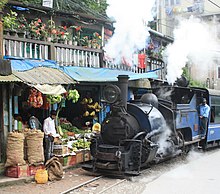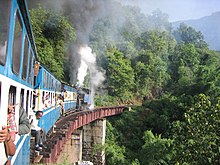
The few remaining Narrow-gauge railways (toy trains) in India are relics of the colonial era, which are mostly built in the late 19th century for the annual relocations of the British civil servants to more pleasant, higher-lying and therefore cooler summer capitals. They are therefore not only of tourist interest for railway enthusiasts, but also provide a convenient way of getting to places worth seeing - often with a touch of colonial decadence in 1st class.
General
The trains are operated by the state railway. Reservations are therefore possible via their system, but associated with the usual difficulties. It can be difficult to get seats, especially at the time of regional festivities and around the Divali festival at the end of October. If in doubt, book an unconfirmed reservation.
Because of the low prices, Europeans shouldn't be afraid to travel in 1st class. But traveling in second class is also possible without any problems. There may be baggage restrictions, but most of them are not enforced. So you can stow your luggage well under the seat.
Many of the routes are mainly used by Indian tourists. But some also have an important function for the local population.
stretch
The tracks mentioned are as UNESCO world heritage recognized, apart from the route to Matheran, here the admission has only been applied for.
Darjeeling Himalayan Railway


Probably the best-known and certainly the most worth seeing narrow-gauge route (610 mm) leads over 78 km from the 1 New Jalpaiguri Railway Station (NJP; 114 m above sea level), this is the main station of the metropolis Siliguri, to 1 Darjeeling![]() (2135 m) in the center of the famous tea-growing district in northeast India. The route is part of the UNESCO World Heritage. The damage caused by landslides, which led to the route being interrupted for several years, was almost completely eliminated by November 2014.
(2135 m) in the center of the famous tea-growing district in northeast India. The route is part of the UNESCO World Heritage. The damage caused by landslides, which led to the route being interrupted for several years, was almost completely eliminated by November 2014.
According to the timetable, the route with 13 stops takes eight hours (almost 10 km / h), most journeys take over eleven hours. The path leads over several switchbacks and 360 ° degree loops. The proverbial flower-picking of the route, which is often at arm's length from the wooded mountain slope, is quite possible.
- getting there
NJP is on the important transit route from Assam to Kolkata and along the Ganges to Delhi. There is also a long-distance bus from Kathmandu to Siliguri (1½ days), which does not run regularly during the monsoons.
Nilgiri Mountain Railway


The 26 km long Nilgiri Mountain Railway is the only narrow-gauge railway in southern India in the state Tamil Nadu. The train travels through the "blue mountains" to the center of the Nilgiris Hills District. You will between Mettupalayam (326 m) and Udhagamandalam (2203 m), the official name of the station Ooty (= Ootacamund), still operated by steam locomotives, on part of the route as a rack railway. It leads over around 250 bridges. According to the timetable, it takes just under five hours uphill and 3.5 hours downhill - 5 times a day. During colonial times, Ooty was the seat of government from May to October Madras Presidency.
- accommodation
- 1 Solomon House, Missionary Hill, (Behind RTO Office), Coonoor Road, Ooty, 643001. Tel.: (0)423-2447506, Email: [email protected]. (In the international youth hostel association.).Price: Dorm: Rs. 250, Double: Rs. 2000 .; (Off-season around 30% lower.) (As of 2015).
- getting there
From the next major train station Coimbatore Junction You first drive to Mettupalayam (4 trains a day), the start of the route. With the Nilgiri Express (Train № 12672) you can get to / from directly once a day Chennai (around 530 km).
The bus station with regular connections to Coimbatore is located near the train station of Ooty (80 km), Calicut (187 km) as well as over Mysore (166 km) to Bangalore (277 km).
Kalka – Shimla Railway

The Kalka – Shimla Railway connects the towns over 96 kilometers Kalka (658 m) and the beautiful former summer capital of British India, Shimla (2076 m). The route with over 860 bridges is now only used by diesel locomotives. Of the 107 original tunnels, 102 are still in use.
The four daily trains up, with one exception, leave Kalka early in the morning between 4 and 6 a.m. The last departure is with the Himalayan Queen at 12.10 (train number 255; connection to Delhi).
- getting there
The 276 km long connecting route Delhi–Kalka is now fully electrified. During the hot high season and for the local festival at the beginning of October - when the rooms in Shimla are also fully booked - it can be difficult to reserve 1st class tickets. If necessary, the foreigner booking office on the upper floor of the New Delhi train station can help. To get to Shimla, the train is the local, poorly maintained buses or overpriced taxis Kalka-Shimla Taxi Union (Tel .: 91 177 2658225) to be preferred in any case.
(Flights to Shimla Airport (IATA: SLV, ICAO: VISM), a miniature landing pad designed for a maximum of 50 passengers, in Jubbarhatti, 22 km away, has been since the bankruptcy of Kingfisher no more travel alternatives.)
- accommodation
There is no reason to stay in Kalka. For longer stops is the retiring room of the train station sufficient.
Matheran Hill Railway


The 21 km long route (track width 610 mm) between Neral (40 m above sea level) and Matheran (ø 800 m) in the Western Ghats in what is now the state Maharashtra was built 1901–1907. Only diesel locomotives have been used since the 1980s. During the monsoon season there may be lengthy closures. First class tickets cost about seven times the second.
Matheran is India's only car-free hill station (plastic bags are also prohibited). A tourist tax is required per visit (2012: Rs 25). Because of its proximity to Mumbai (90 km) and Poona (120 km) it is a popular destination for Indian weekenders, so accommodation is becoming scarce. A visit is particularly suitable for those who cannot visit any of the larger hill stations in the foothills of the Himalayas, or who do not want to spend a few days in the big city before their flight home. Matheran has, which is atypical even for hill stations in India, a sizeable network of hiking trails in good condition. You can walk around on them on the plateau of Table Mountain without major differences in altitude. There are a variety of viewpoints. In the forests of the surrounding mountains there are numerous wild monkeys and you can explore the bird and insect world.
- accommodation
Hotels in Matheran are overpriced by Indian standards and often require a stay of at least two days.
- 2 Hope Hall Hotel, Plot Number MT-77 M.G. Rd., Matheran 410 102. Tel.: 91 2148 230253. Shower out of the bucket, bring your own towels if possible. There are also cheaper, smaller rooms.Open: 9:00 a.m. to 1:00 p.m.Price: 4-bed: 2500 Rs, 5-bed: 3500 (no smaller rooms); Low season approx. 35% cheaper; no discount for children.
- getting there
Neral Junction can be reached from Mumbai Central Station (CTS) by local trains, notorious for their notorious overcrowding. However, these are not yet overcrowded in Neral that far from Mumbai and you have a good chance of getting a seat. Express trains on this route are the Deccan Express or the Koyna Express. From Poona you can easily get there with the morning Sinhagad Express in around two hours to Karjat, the remaining short distance to Neral by local train. Combined tickets are sold at Matheran's train station for the toy train and the connection in Neral on the main line, but only for the local area.
Kangra Valley Railway

The 164 km long route from Pathankot (330 m) across Ahju (1290 m; route kilometers 155) to Joginder Nagar in Himachal Pradesh is interesting for tourists, as Ahju was a transit point three kilometers away Bir which, because of its large exile Tibetan community, has become a center for ecotourists, volunteers and meditators. The 762 mm track was not built until the 1920s. Tunnels were avoided in the routing. It leads, especially in the section from Mangwal to Kangra, along partly breathtaking mountain panoramas. Most of the 6-7 trains a day run in both directions in the morning and usually only offer second, that is to say in India “wooden bench class”.
In recent years there have been several business interruptions, as illegal gravel and sand mining in the river bed led to the tracks being washed away. On the one hand, the railway is on the World Heritage applicant list, on the other hand, the Ministry of Railways is planning to expand it to Indian broad gauge.
Others
There are other narrow-gauge railways that may be of interest to enthusiasts, but do not open up any touristy areas, for example:
- the Satpura railways around Jabalpur and Gondia in Madhya Pradeshwhose track widening from 762 mm to wide gauge is already being carried out.
- the Gwalior Light Railway, connects over 199 km 2-3 times a day Gwalior Junction with Sheopur, the maximum speed is 35 km / h.
Otherwise, some private companies operate narrow-gauge railways, mainly in Bihar Carrying sugar cane, elsewhere in steelworks.
Web links
- Indian State Railways reservation website (English; slowly loading)
- Online course book “Trains at a Glance”
- Description of a ride Kalka-Shimla and Darjeeling Railway
- Pathankot-Jogindar Nagar Kangra Valley Rail (engl.)
- Indian Steam Railway Society


